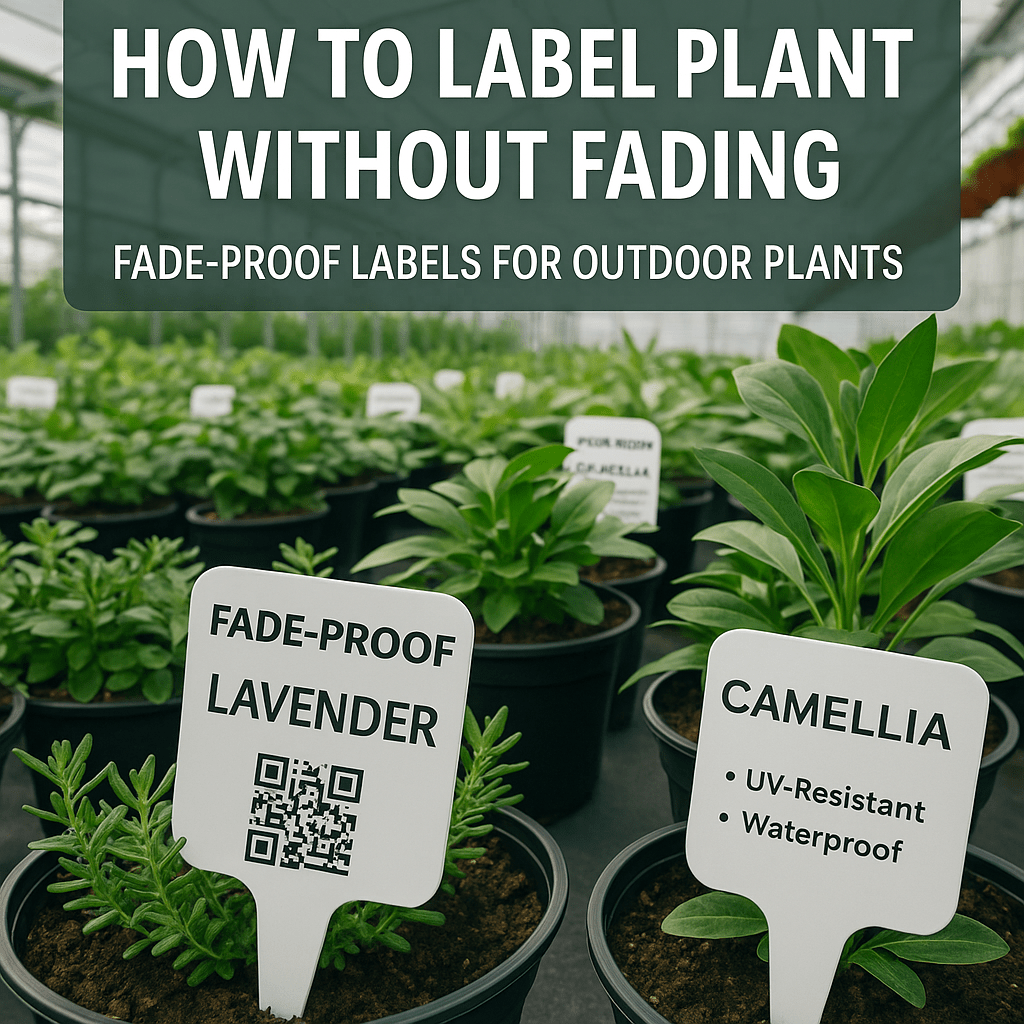If you’ve ever stepped into your greenhouse or garden and found your plant labels faded, peeling, or unreadable, you’re not alone.
Sunlight, moisture, and time can destroy ordinary labels, especially those printed with inkjet or handwritten with markers.
For professionals in nurseries, greenhouses, and botanical gardens, durable labeling isn’t just a nice-to-have. It’s essential for inventory control, plant identification, and brand presentation.
In this guide, we’ll explain how to label plants that won’t fade, even after months of sun, rain, and watering cycles.
☀️ Why Plant Labels Fade
The three biggest causes of fading in outdoor plant labels are:
-
UV exposure – Direct sunlight breaks down dyes and pigments in ink.
-
Moisture and humidity – Water seeps into porous paper, smearing or lifting ink.
-
Temperature swings – Hot-cold cycles cause expansion, contraction, and cracking in label surfaces.
To prevent these issues, you need the right material, printing method, and ribbon type.
🏷️ 1. Choose the Right Label Material
The label’s material determines how long it survives in outdoor environments.
| Material | Lifespan | Best Use | Resistance |
|---|---|---|---|
| Paper | Weeks | Indoor or short-term | Poor water and UV resistance |
| Polypropylene (BOPP) | 6–12 months | Greenhouses, moderate exposure | Water-resistant, not UV-proof |
| Polyester (PET) | 1–3 years | Nurseries, farms, outdoor signage | UV and water-resistant |
| Vinyl (PVC) | 3+ years | Tree tags, long-term outdoor labeling | Extreme weather and UV resistance |
For nurseries, the most durable option is thermal transfer synthetic labels (polyester or vinyl). They’re engineered to resist fading, moisture, and chemicals.
Tip: Avoid lamination for small tags — it tends to peel under constant watering.
🔥 2. Use a Thermal Transfer Printer
Unlike inkjet printers, which use liquid ink, thermal transfer printers use heat to bond resin ribbons into the label surface.
This process produces permanent, fade-proof prints ideal for outdoor environments.
✅ Advantages:
-
Waterproof and UV-resistant prints
-
Smudge-proof and scratch-resistant
-
Suitable for plastic tags, wraps, and stakes
-
Fast and cost-effective for large batches
Recommended models for nurseries:
-
GoDEX RT700i+ – for daily plant labeling, loop tags, and pots
-
GoDEX ZX420i+ – 300 DPI precision for brand logos and fine print
-
GoDEX HD830i+ – wide-format printer for tree tags and signage
Each supports resin ribbons, which are crucial for longevity.
🧴 3. Use Resin Ribbons, Not Wax
The ribbon type you use affects print durability as much as the printer itself.
Resin ribbons are formulated to withstand heat, moisture, and UV light.
| Ribbon Type | Durability | Suitable For |
|---|---|---|
| Wax | Low | Paper, short-term use |
| Wax-Resin | Medium | Polypropylene labels |
| Resin | High | Polyester or vinyl labels |
For outdoor plant labels, always choose resin-based ribbons. They melt into the label material, creating a weatherproof bond.
🧠 4. Print Clear, High-Contrast Text
For maximum readability:
-
Use black on white or silver labels — high contrast enhances legibility.
-
Avoid overloading tags with text; use short plant codes or QR links.
-
Print in 300 DPI or higher for barcodes and fine text.
GoDEX printers like the ZX420i+ and HD830i+ produce crisp 300 DPI resolution prints suitable for microtext and QR-coded tags.
🌿 5. Proper Label Application
Even the best materials won’t last if labels are applied poorly.
Here’s how to maximize adhesion:
-
Apply labels to clean, dry, smooth surfaces.
-
Avoid applying when surfaces are cold or wet.
-
Use adhesive tags for pots and containers, and loop or stake tags for soil.
For extra durability, consider laminated polyester tags for branding and care information.
⚙️ 6. Test Under Real Conditions
Before printing in bulk, test your tags for:
-
UV exposure (place samples in full sun)
-
Water resistance (daily irrigation test)
-
Abrasion resistance (rub test for smudging)
GoDEX’s GoLabel software lets you store templates and reprint easily once you find the optimal material setup.
🧩 Example: A Proven Setup for Fade-Proof Plant Labels
Printer: GoDEX HD830i+ (8” wide, 300 DPI)
Material: Polyester matte white
Ribbon: Full resin
Use case: Outdoor tree tags and nursery signage
Result: Labels remain legible for 2+ years without fading.

✅ Final Takeaway
To prevent fading, focus on three things:
-
Synthetic label materials (polyester, vinyl)
-
Thermal transfer printing (not inkjet)
-
Resin ribbons for weatherproof durability
With the right setup, your plant labels can last for years outdoors, staying readable, professional, and on-brand no matter the weather.

